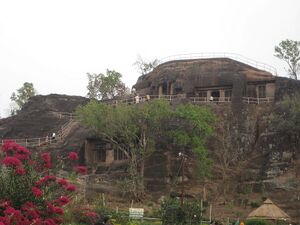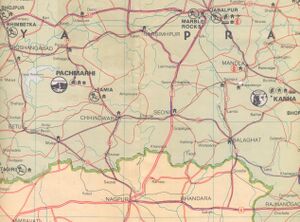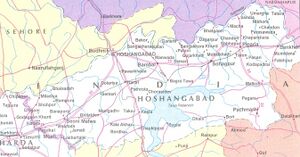Pachamarhi
| Author:Laxman Burdak, IFS (R) |



Pachmarhi (पचमढ़ी) is a hill station in Hoshangabad district of Madhya Pradesh state of central India. Author (Laxman Burdak) visited it on 04.06.1989, 20-27.01.1991.
Location
It is widely known as Satpura ki Rani ("Queen of Satpura"), situated at a height of 1067 m in a valley of the Satpura Range in Hoshangabad district. Dhupgarh, the highest point (1,352 m) in Madhya Pradesh and the Satpura range, is located here. It is a part of Pachmarhi Biosphere Reserve.
Origin
Variants
- Panchamarhi/Panchamadhi (पंचमढ़ी), म.प्र., (AS, p.513)
- Pachamadhi/Panchamadhi (पंचमढ़ी)
- Pachmarhi
- Pachmadhi
History
The name Pachmarhi is believed to be derived from the Hindi words Panch ("five") and Marhi ("caves"). According to a legend, these caves were built by five Pandava brothers of Mahabharatha era during their thirteen years of exile. The caves are situated on a hilltop and provide an excellent vantage point.
Before British the Pachmarhi region came under the kingdom of the Gond king Bhawut Singh, although it was not a populated village or town at that time. Captain James Forsyth of the British Army along with Subhedar Major Nathoo Ramji Powar who was later made the Kotwal (Incharge of the armoury (Koth) of Pachmarhi, spotted the plateau in the Pachmarhi region in 1857, while leading his troops on the way to Jhansi.[1] It quickly developed into hill station and sanatorium for British troops in the Central Provinces of India.
The population in 1901 was 3,020, rising to double that number in the hot summer months. Pachmarhi also served as the summer capital for the Central Provinces.
The forest around the town is home to many rare varieties of plants. UNESCO added Pachmarhi park to its list of Biosphere Reserves in May 2009. The total area of Pachmarhi Biosphere Reserve is 4981.72 km2. It is located at longitude 22° 11’ to 22° 50’N and latitude 77° 47’ to 78° 52’E. It covers parts of three civil districts, viz., Hoshangabad (59.55%), Chhindwara (29.19%) and Betul (11.26%). It includes three wildlife conservation units viz., Bori Sanctuary 485.72 km2), Satpura National Park (524.37 km2) and Pachmarhi Sanctuary (491.63 km2).
पंचमढ़ी
विजयेन्द्र कुमार माथुर[2] ने लेख किया है ...पंचमढ़ी (AS, p.513) मध्य प्रदेश की सतपुड़ा पर्वतश्रेणी में समुद्र के तल से 3,500 फुट से 4,000 फुट तक की ऊँचाई पर नर्मदा नदी के निकट स्थित एक पहाड़ी स्थान है। इसका नाम पांच मढ़ियों या प्राचीन गुफ़ाओं के कारण है, जो किंवदंती के अनुसार महाभारत कालीन हैं। कहा जाता है कि अपने एक वर्ष के अज्ञातवास के समय पांडव इन गुफ़ाओं में रहे थे।
कुछ विद्वानों का यह मत भी है कि पंचमढ़ी की ये गुफ़ाएँ वास्तव में बौद्ध भिक्षुओं के रहने के लिए बनवाई गई थीं। आधुनिक काल में पंचमढ़ी की खोज 1862 ई. में कैप्टन फोरसाइथ ने की थी। उन्होंने 'हाइलैंड्स ऑफ़ सेंट्रल इंडिया' नामक एक ग्रंथ भी लिखा था। उन्हें मध्य प्रान्त के चीफ़ कमिश्नर सर रिचर्ड टेम्पल ने सतपुड़ा की पहाड़ियों के [p.514]: इस भाग के अन्वेषण के लिए विशेष रूप से भेजा था।
पंचमढ़ी में अब से लगभग सौ वर्ष पहले गोंड और कोरकू नामक आदिवासियों का निवास था। यहाँ की अनेक चट्टानों पर आदिम निवासियों के लेख पाये गए हैं। उनके चित्र भी शिलाओं पर उत्कीर्ण हैं, जिनके विषय मुख्यत: ये हैं- गाय, बैल, घोड़ा, हाथी, माला, रथ, रणभूमि के दृश्य तथा शिकार। गोंडों के इतिहास के ज्ञाताओं का कथन है कि गोंडों में प्रचलित किंवदंती में उनके जिस मूल स्थान काचीकोपालोहागढ़ का उल्लेख है, वह पंचमढ़ी का बड़ा महादेव और चौरागढ़ ही है। चौरागढ़ आज भी गोंडों का प्रसिद्ध देव स्थान है। यहाँ के देवालय में शिव की मूर्ति है, जिस पर भक्त लोग त्रिशूल चढ़ाते हैं। बेतवा (वेत्रवती) नदी का उद्गम पंचमढ़ी के निकट स्थित धूपगढ़ शिखर से हुआ है, जिसकी ऊँचाई समुद्र तल से 4454 फुट है।
पंचमढ़ी परिचय
पंचमढ़ी को 'मध्य प्रदेश की छत' भी कहा जाता है। पंचमढ़ी का नाम पाँच मढ़ियों या प्राचीन गुफ़ाओं के कारण पंचमढ़ी पड़ा है। यहाँ महादेव पहाड़ी के शैलाश्रयों में शैलचित्रों का भण्डार मिला है। इनमें से अधिकतर शैलचित्र पाँचवी से आठवीं शताब्दी के हैं, किंतु सबसे प्राचीन चित्र दस हज़ार साल पहले के माने जाते हैं। महादेव पर्वत शृंखलाओं में 5 मील (लगभग 8 कि.मी.) के घेरे में लगभग पचास शिलाश्रय चित्रित पाए गए हैं। इन गुफ़ा एवं चित्रों की खोज का श्रेय डॉ.एच. गार्डन को दिया जाता है। इन गुफ़ाओं के चित्र आदिकाल से ऐतिहासिक काल तक निरंतर रचे गए थे। पूर्वकाल के चित्र डमरुनुमा तथा तख्तीनुमा मानवाकार वाले हैं तथा बाद के काल के चित्र परिष्कृत रूप में दृष्टिगोचर होते हैं। इस स्थल की मुख्य गुफ़ाएँ- इमली खोह, बनियाबेरी, मोण्टेरोजा, डोरोथीडीप, जम्बूदीप, निम्बूभोज, लश्करिया खोह, भांडादेव आदि हैं। पंचमढ़ी के चित्रकारों ने मानव जीवन के सामान्य जन-जीवन की झाँकी बखूबी चित्रित की है। इन गुफ़ाओं में शेर का आखेट, स्वस्तिक की पूजा, क्रीड़ा नर्तन, बकरी, सितार वादक, गर्दभ मुँह वाला पुरुष, तंतुवाद्य का वादन करते पुरुष, दिव्यरथवाही, धनुर्धर तथा अनेक मानव व पशुओं की आकृतियाँ चित्रित की गई हैं। सर्वाधिक चित्रण शिकार पर आधारित है।
संदर्भ: भारतकोश-पंचमढ़ी
External links
References
- ↑ Pachmarhi Travel Guide. Goodearth Publications. 2009. p. 6. ISBN 978-81-87780-95-3.
- ↑ Aitihasik Sthanavali by Vijayendra Kumar Mathur, p.513-514

